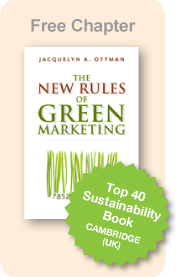Jacquie Ottman's
Green Marketing Blog
The Power of Green Lies In Marketers’ Hands
October 22, 2008 by Jacquelyn Ottman
Many people think the power to restore our environment lies in the hands of technical types like scientists and engineers, even lawyers and legislators. But the real power of green lies in the hands of marketers - we, the creative folks who have the power to design and promote cleaner products and technologies and help consumers evolve to more sustainable lifestyles.
It may be hard to fathom, but over 75% of the environmental impact that a product throws off during its lifetime is determined at the design stage, when, for instance, the materials are chosen, the recyclability of a product is determined, and when the amount of toxic chemicals it embodies is decided. And it doesn't stop at the design stage. Marketers often determine the concept, too. That's where the real leverage for our innovative skills comes in!
Consider a toothbrush. Want to lessen its environmental impact? Start by making it out of recycled plastic, plastic made from corn, and educate on how to recycle or compost it. Then make the head replaceable and recyclable, too. Cut down on its packaging by only wrapping the bristly head. Think you're finished? Not a chance! That's because the toothbrush is part of a system-the water, the toothpaste and the box the toothpaste comes in.
Now multiply all of these impacts over one consumer's lifetime and then again for all the consumers on earth at one time. These cumulative impacts may pale in comparison to substituting an entirely new concept; let's say a stick of edible chewing gum laced with germ fighting enzymes.
Now strategize its way into consumer's hands. Thinks it's too much of a leap to market this idea to adults who might be set in their ways or creep out on the idea of enzymes in their chewing gum? Then start to seed the concept into society by appealing to children. Enlist the help of a "Sesame Street" character and target parents looking to end the nightmare of getting the kids to brush.
Ever heard of a chemist thinking this way? Hell no!
Marketers, start your engines! We're the ones who can dream up new product concepts, and we're the ones who can sell them to mainstream consumers (not just the deep green consumers who are born predisposed to all things "eco.")
Take the Toyota Prius. A fine car with a hybrid engine. Premium price, not too likely to be offset by fuel savings. So what gets consumers over the premium price hump as well as the risk posed by new technology? Answer: A distinctive silhouette that helps owners project their values, on-the-mark advertising that focuses upon such direct benefits as super quiet ride and fuel efficiency. And a publicity machine that engenders the priceless support of Hollywood celebrities showing up at the Oscars in a Prius rather than a stretch limo.
Want to start making a difference on your job? Consider the many other solutions that are waiting in the wings with the potential to capture the attention of consumers with your help. For instance, we already know how to design homes and offices that use energy sparingly. We already know how to make construction materials and commercial and household furnishings that reduce the threats of indoor air pollution. We know how to design kitchens to make it easy for people to recycle and compost waste. We know how to reuse water from indoor plumbing systems to make lawns and gardens thrive. We know how to grow food using fewer or no chemical pesticides and fertilizers.
Some of these technologies are being embraced by deep green consumers. But to really make a difference, they need to be embraced by the mainstream. That's where marketers can come in. Ask: What will it take to: Make greener products and behaviors cool? Get all consumers paying the small premiums necessary to bring such products to market? Look to some recent green marketing history for help.
Jimmy Carter wearing a sweater wasn't cool, and it didn't motivate consumers to turn down the thermostat. But the Energy Star label is cool. Why? It relies on technology to create products that are highly efficient as well as high quality (read: requiring no trade-off in consumer habits). A decade's worth of advertising focusing on such benefits plus the attendant savings on home and office electric bills now make the Energy Star label the second most recognized eco-label behind the three chasing arrows denoting recycling.
Herman Miller's Mirra Chair is cool. It not only adheres to strict protocols for eliminating toxics in its manufacture, it can be disassembled for recycling in 15 minutes with normal tools. It is now on its way toward becoming a design icon in its own right, environmental attributes or not.
Tom's of Maine line of personal care products, now owned by Colgate-Palmolive, stresses all that consumers desire in today's personal care offerings: natural (read: safe), good-tasting, and trustworthy. (How many toothpastes do you know that come with an ingredient statement with a full explanation of each ingredient's role, as well as a letter from the head of the company?)
Take a shot at applying your own creativity to develop and market new products that allow consumers to live their lives more sustainably - and make some green marketing history yourself!
Click here to join our mailing list.



 ShareThis
ShareThis

